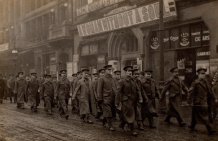Articles

Image courtesy of Chris Grosvenor
Thousands of WW1 soldiers packed out bombed buildings to watch films
Cinema-going was so popular among troops serving in the trenches in World War One thousands regularly packed into bombed out buildings near the front line to watch the latest films, new research shows.
There were double the number of military cinemas on the Western front than previously thought, a University of Exeter historian has found. The extent of film-going by troops during 1914 to 1918 has previously been overlooked by historians.
The makeshift cinemas, in abandoned town halls, barns, purpose-built huts or simply in the open air, were often only a few miles behind the trenches. Soldiers were assigned roles as projectionists or to secure the latest releases from film distributors back home, and often managed to put on screenings three times a day despite having to use equipment prone to failure and work in basic conditions.
The study, which shows the huge part films played in the lives of British soldiers, is a result of years of analysis of documentation and diaries by researcher Chris Grosvenor. Mr Grosvenor has found 66 per cent of British Expeditionary Force formations (including Armies, Corps and Divisions) serving on the Western front had their own military cinema. This means 52 military formations were operating a cinema during the war, and 73 per cent of British Divisions serving on the Western front were able to offer film screenings for their men.
This is the first full analysis of records held in the National Archives, particularly of the war diaries produced by the Quartermaster General for each Army, Corps and Division of the British Army which served on the Western front to see how soldiers spent their leisure time.
Mr Grosvenor said: “For soldiers the cinema was not a disposable or arbitrary way to spend their free time, but a much needed psychological respite from the immediate dangers of trench warfare: a cathartic, morale-boosting release from the ever-present, impending aura of doom that permeated life on the front lines.”
Soldiers were most interested in watching slapstick comedies starring early icons like Charlie Chaplin, but other genres and types of films made their way to the front. However, soldiers were frequently dismissive of topical fiction or documentary films depicting the war itself, such as the famous documentary The Battle of the Somme.
“Soldiers often approached these types of films with caution” said Mr Grosvenor, “mocking the overly sentimentalised, censored, or even staged scenes which could never compare to the reality of what soldiers experienced on a day to day basis”. Soldiers could be silent and rapt during the beginning of films, and during love scenes. But they would boo and hiss if they saw a villain, and cheer for a happy ending. These screenings were often accompanied by the ever-present sound of gunfire and shelling.”
Cinema-going took place during the days soldiers spent at rest. It was common for a soldier to spend only two weeks in the trenches, alternating every four days or so between the front line and reserve trenches, followed by six days leave in a rest camp further back behind the line. Reports describe 300 men queuing up to get into a venue whose capacity was 200. Other evidence shows 1,190 officers and men attending one packed showing, with no space to fit others queuing outside.
There were also mobile cinemas so films could be shown in remote locations, and often in the midst of towns and villages which served as rest areas for British troops. Some of the military cinemas could not remain constantly open, as divisions traded equipment, were relocated elsewhere along the front, or because there was no time or manpower.
Mr Grosvenor said: “At first many of the films shown to soldiers in the makeshift cinemas were old. But this changed as the war progressed. Deals were struck with film distributors to supply the latest films. There was even an ‘Army Film Depot’ near Dunkirk, where films were stored.”
Very few of the military records consulted ever recorded specific films shown by name. But representative records for 4 Corps for two months in 1918 shows that during this time 79 per cent of the films screened were comedies, whereas only 18 per cent were dramas and 3 per cent cartoons.
Many fixed cinemas relocated frequently as soldiers were moved along the front line. The war diaries of the 4th Division’s Quartermaster General recorded sixteen separate locations for the divisional cinema between it being established in January 1915 to the close of the war in November 1918.
Proceeds from entrance fees were used to pay for the costs of running the cinemas. The average price appears to be around 30 centimes for men and 1 franc for officers – because they earned more or because this would buy them superior seating. An infantry private serving on the front line was paid on average the lowly sum of 1 shilling per day, roughly equating to just over a franc. Any profit was paid into divisional “canteen” or social funds.
In November 1917 the 1st Division’s cinema took 1258.70 francs, suggesting it attracted around 3 officers and just over 400 men daily. Similar estimations for the 49th Division cinema shows it had a daily attendance rate of 2 officers and 135 men, suggesting a smaller venue or more limited scale of operation.
Mr Grosvenor said: “It is my hope that my research has gone some way towards bridging the gap between cinema audiences of today, and cinema audiences of a century ago, particularly at a moment like this in 2018 with the centenary commemorations for the end of the war in November 1918”.
Date: 7 November 2018
